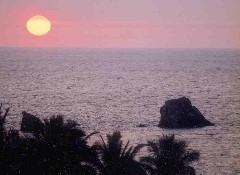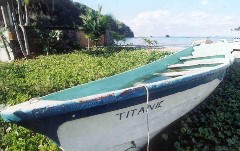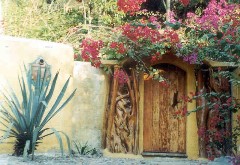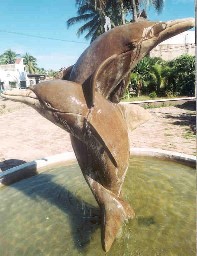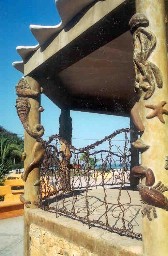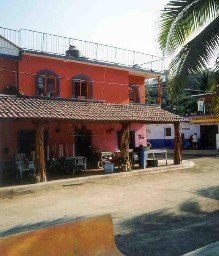Deep down in all of our hearts, there is that desire to escape the everyday world in which we feel trapped and find our personal paradise. Or, to be more precise considering the limitless alternatives of that thought, how would one conceive of their own paradise? Perhaps to some it would be a deep, dark forest high in the mountains, alive with the sounds of unseen wild creatures. To others it might be an uncomplicated place by the seashore, quiet except for the surf rolling onto a gentle beach, and beautiful in the simple but elegant style that nature provides.
That second thought is what my heart sought, and that’s what I found. I offer up its story with the understanding to the reader that this is a very special place, and I must put entry restrictions upon you if you choose to visit it.
Only those people seeking a place to go where there is nothing to do, and enjoy doing nothing while there, are allowed in. Only those who greet the day and every one on the street as they pass with a smile may enter. Only those who do not need television to pass the night, but prefer instead conversation over a dinner of fresh caught fish and fine wine with friends, and later, to read a good book that lulls you to sleep, will find this paradise open to them.
Imagine entering the Bahía Tenacatita on your own sailboat just as the sun has set at your back and the lights of civilization off your bow guide you toward your anchorage. To be truthful, there are not that many lights along the great curving bay. To your right, off the starboard bow, is the largest concentration. It is the village of La Manzanilla. Directly ahead are the lights of two resort complexes, one resting on the sand of Playa de Los Angeles Locos, the other a complex of villas that climbs a rocky point high above the breaking surf. To port, to the left, a number of rocky islets mark the beginning of Tenacatita, a broad sweeping beach lined with rustic palapa restaurants. You slowly slip into a quiet bay midway between Tenacatita and the resorts and drop anchor in a calm shelter.
Taking the dinghy ashore the next morning, you begin your adventure of exploring all the wonders of this quiet backwater known as the Costa Allegre, the happy coast. You begin, as I did, at the southern-most part of the bay, the fishing village of La Manzanilla.
There is really not much to the town. It is off the main coastal road, Highway 200, that links Puerto Vallarta to the large, busy seaport of Manzanillo. But what will be found down a one mile long turnoff to the beach is a small village that offers a sense of serenity, a quiet walk on the beach at sunrise or sunset and a peace of mind that comes with the realization that the world doesn’t have to be so complicated.
In other words, this is a paradise that my heart could imagine.
The one unpaved main street of sand splits at a small triangular plaza into two that meet again in the square in front of the church. A small jardín occupies the space, crowned with an unusual gazebo whose concrete pillars are overflowing with stylized creatures of the sea. A few side roads go off from this square either up a river valley, the streambed dry except for the rainy season, or up the steep hill behind the church overlooking the jardín.
Few vehicles travel these few streets. The traffic consists mostly of people on foot or riding bicycles, the preferred mode of transportation in the town, it seems.
The beach curves from a rocky point near the square around the huge bay, stretching for miles as far as the eye can see. The water’s edge is lined with coconut palms and small beach homes and rustic restaurants in the town proper, but beyond the last palapa, only the sand and palms are visible until you see the villas of Punta Serena high upon their rocky bluff.
Two notable events in recent years have shaped this town into what exists today; first came the quiet arrival of foreigners who decided to settle down and make it a home, notably a mysterious Italian Contessa and a German couple with their young son.
The Contessa had a vision of turning the town into a mini Malibu, complete with expensive houses lining the beach. The couple opened a small inn.
It took a violent act of nature, in this case the thunderous arrival of a huge tsunami that laid waste to most of the beachfront property, to make her vision a reality.
The two events are linked, for after the tidal wave, more foreigners came and purchased property that had been abandoned, and began a rebuilding project that changed the face and beach front of the town forever. But it did not become the Malibu look-a-like that the Contessa had imagined. It became something quite different.
Now, large multi-level apartments and condominiums climb the steep hillside above the beach; inventively designed homes crown the top of the hills or nestle in small canyons. The local population turned away from what had been a fishing economy to embrace the new construction boom. Where once there had been little work available, now high paying jobs were everywhere.
They began the process of rebuilding their own homes with the income earned, and soon any visible scars from the sea-borne disaster disappeared. More foreigners came, many with homes in San Miguel de Allende, and saw what was happening, and soon a small expatriate community was created, all like-minded people who loved the place, the locals and the sea.
And so, La Manzanilla began a new existence.
Apart from the sound of the rolling surf and the frequent passage of shrill, squawking flocks of brilliant green parrots, the only noise that intrudes upon the solitude of the town is a musical gas truck alerting residents to its appearance.
One typically Mexican phenomenon, the lack of cambio or monetary change for services or goods purchased, is surprisingly missing from this town. It is a small blessing, but noteworthy in that there is no bank to be found. Nor is there a gas station. With only one cantina, Saturday night is a relatively quiet time, a fact that the town’s two policemen appreciate.
Quite comfortable accommodations can be found for the visitor, either rentals directly on the beachfront, or condos in the hills above town with magnificent views of the beach and bay. The following three establishments offer special charms and comforts.
At the rocky point near the jardín, nestled on a craggy overlook, is Casa Maguey, a small inn containing three distinctive casitas. It has been owned and managed by Helga Lehmen for fourteen years and provides solitude and privacy from the town proper, although the beach is only steps from it’s bayside entrance.
On the hillside overlooking the church and jardín is Brisas del Mar, although if you asked any local, few would know it by that name. It is one of the largest structures in town and contains two one-bedroom apartments and two two-bedroom units, all fully furnished with kitchens, VCR’s and satellite TV with air conditioning provided for the bedrooms. But, because of its location high on the hill, the sea breezes cool the rooms naturally.
On its rooftop is a large open lounge area with an infinity pool and crowned by a large palapa. The terrace is complete with small kitchen and bar for preparing food and drink to entertain, or it is simply a place to lay back and enjoy the view and sunset.
At the other end of town, away from the beach up a short street, are seven apartments owned and operated by Maria Castilozo. They are furnished in a rustic country style, with a number of terraces and patios available to all the guests. Maria is actively involved in civic affairs, promoting ecological efforts to keep the town clean and protect its environment, a dedication first brought to my attention by the proprietor of the town’s really fine restaurant.
Martín spent 19 years in the restaurant business, mostly in Guadalajara, at one of that city’s finest establishments. He finally decided to set out on his own, and went to Barra de Navidad with the hopes of opening his restaurant.
He was disappointed at what he found there, and so traveled a little further up highway 200 until he found a fishing village in need of his services. He opened his namesake, Martín’s Restaurant, five years ago, first on a location near the jardín, but then decided his patrons would appreciate the sea view and breezes, and so built a two-story palapa near the rocky point and riverbed.
He personally oversees the kitchen, buying fresh produce and seafood daily and preparing specials each night. But, if a guest wishes something not on the menu, he will do his best to fulfill the request.
If you walk the beach away from town, you will ultimately encounter what remains of a hotel that was destroyed in the tidal wave. The property clearly was quite large and developed at the time, but now only a hulk of concrete, one end collapsed upon itself, remains. A chain link fence surrounds it, and one can only speculate as to its future.
A little further on, and you reach Bocas de Iguana, a campsite and trailer park.
Playa de Los Angeles Locos is not named for some demented celestial beings, but rather for a group of wealthy gringos from Southern California who first developed the site and were regarded by the locals as crazy because they would fly back and forth in their plane to the site. They constructed two distinct and separate properties and targeted each to different clientele. Both properties face a small bay, and it is here that most sailors entering Bahía Tenacatita find safe haven and a quiet anchorage. The resorts changed hands in time and now are know as The Blue Bay Club Los Angeles Locos and Punta Serena Villas and Spa.
The larger of the two is The Blue Bay Club. It is an all-inclusive family style resort that fronts of the wide beach. It contains a number of restaurants and also a large disco. Overlooking this complex are the villas of Punta Serena, a hideaway designed for adults only. It also is all-inclusive and features clothing optional areas, cliff side Jacuzzis, spa treatments and a Temazcal, a Mexican style sweat lodge including purification ceremonies twice weekly. Although designed as the ultimate, intimate escape, guests can also use all of the facilities of The Blue Bay Club. Nearby a heliport stands ready so that guests can be whisked away by air if desired.
In stark contrast to these resorts, Playa Tenacatita is a simple, South Seas type of laid back, nothing much going on kind of place. The broad, sweeping beach is lined with modest palapa restaurants, and the nearby rocky coves that mark the end of the bay provide for excellent snorkeling. If you wish, you can hire a small boat to take you further out to the islands of Colorada, Coocina, San Andrés, Pasavere, Novilla, Esfinge, San Pedro, San Agustín and La Negrita. All are excellent fishing and diving spots.
But perhaps the best that can be said about Playa Tenacatita is that in its simplicity, the best part of living is merely enjoying life over a good meal of fresh seafood and a cold beer. And isn’t that what paradise should be all about?
One final footnote to this record of paradise. It should be mentioned that all along the sweeping beaches, or more correctly, just behind them, are brackish, salt-water lagoons. These lagoons are filled with all manner of exotic life, including Caimanes. You probably know them better by their English language name: Crocodiles. Enjoy paradise, but watch your step.
This article is dedicated to the memory of Rebecca Bruns who guided many readers to their personal Mexican beach paradise.


